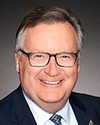Thank you.
My name is Mary Kapelus and I'm the acting assistant deputy minister of the indigenous affairs and reconciliation sector at Natural Resources Canada.
I'll begin by acknowledging that we are gathered today on the traditional unceded territory of Algonquin people. I'd also like to thank you for the opportunity to address this committee as you undertake your community capacity-building and retention of talent study.
This important work is timely at Natural Resources Canada, as we deliver on the government's commitment to advance reconciliation and renew Canada's relationship with indigenous peoples.
Before going further, I would like to introduce my colleague, John Kozij, director general of the trade, economics and industry branch in the Canadian Forest Service; and Jean Gagnon, surveyor general in the lands and mineral sector.
As my CIRNAC and ISC colleagues have referenced, we too believe it is essential to support capacity-building in indigenous communities.
As you may be aware, Natural Resources Canada is responsible for forestry, mining, energy and land-related sciences and geospatial information. This involves collaboration with provincial and territorial partners, universities, industry, and indigenous peoples. At Natural Resources Canada, it is paramount that this work recognize the importance of partnerships and mutual capacity building with indigenous communities.
lt's with this vision in mind that NRCan recently created the sector for which I am responsible, indigenous affairs and reconciliation. This new sector provides a coordinated approach in the department's engagement and consultation efforts with indigenous peoples. This includes enhancing our relationships with national indigenous organizations, supporting the various sectors at NRCan in their activities with indigenous people, and advancing the federal whole-of-government approach to reconciliation.
I'll now go over five initiatives where NRCan directly supports community capacity-building.
First, the Canadian Centre for Mapping and Earth Observation supports capacity-building through the lnuvik satellite station facility. It's making lnuvik and Canada a global data destination. This $20 million satellite reception facility is a global hub for geospatial services and data science in the Arctic built on partnerships with the Gwich'in, the lnuvialiut, the town of lnuvik, the Government of the Northwest Territories, Canadian and international space agencies, and the private sector.
This project also supports skill and capacity development of indigenous students who are recruited to work on projects related to collecting, managing and applying geospatial data, while providing an understanding of satellite operations.
Natural Resources Canada has also sponsored the development of user needs assessments for geospatial data in indigenous communities to increase data relevance for issues such as climate change, disaster management and ocean management.
The second area of NRCan's capacity-building is within the forest sector, which is an important generator of jobs, particularly in rural and remote parts of the country. The indigenous forestry initiative is the latest iteration of NRCan's 30 year legacy of capacity support for indigenous forestry.
Natural Resources Canada is working with communities to build capacity to manage forest resources and support the development of indigenous-owned and operated businesses.
For example, since 2016, NRCan has supported forestry management capacity-building with the Confederacy of Mainland Mi'kmaq, who directly manage forest crown lands in Nova Scotia by integrating indigenous knowledge and western science, leading to broader support for various forestry activities.
NRCan investments have also aided Chapleau Cree First Nation to develop the northeast superior regional chiefs conservation economy strategy, a cornerstone for forest sector economic development. This work has helped to establish the Wahkohtowin, an indigenous-led development corporation that includes a birch syrup business and a forest harvesting operation, bringing jobs and revenue to the local community.
The Indigenous Forestry Initiative fosters partnerships with indigenous communities. lt isn't just program results—it is about how we build lasting relationships. Our boots-on-the-ground presence through regional forestry offices means that we are able to co-develop projects in communities.
The third area I would like to touch on is our innovative and joint efforts to build a cleaner energy future. Through the clean energy for rural and remote communities program, NRCan was provided with $220 million over six years to support clean energy projects. We're collaborating with indigenous communities and organizations as they advance renewable energy and capacity-building projects to reduce their reliance on diesel.
With federal support, the Teslin Tlingit Council in the Yukon has built a forest-based bioenergy plant to heat their community. Teslin maximized the community benefits in each stage of the project. They oversaw the planning, construction and ultimately the operation and ongoing maintenance of their bioenergy systems.
Our off-diesel program has also allocated $10 million in funding toward capacity-building projects related to clean energy. Through this first round of funding we're advancing 11 projects across Canada that range from community energy planning and energy literacy to youth training programs.
These projects are at the very heart of ensuring indigenous communities have greater decision-making regarding their energy future. Every project is community driven and aims to achieve broader socio-economic impacts.
For example, NRCan is supporting a project that will recruit, train and offer professional development to new full-time indigenous energy managers across multiple remote communities in western Canada.
We've also launched the $20 million “Generating New Opportunities”, or indigenous off-diesel, initiative in Whitehorse last week. The goal of the initiative is to help transition up to 15 remote indigenous communities off diesel as their primary energy source.
Over the past 18 months, Natural Resources Canada engaged across the country to ensure diverse needs and perspectives were incorporated into the design of the initiative. This engagement resulted in a flexible design where participants can access the training and support needed to develop a clean energy project that meets the needs of their community.
Investment in clean energy solutions to reduce reliance on diesel in remote indigenous communities is one small but vitally important link in supporting reconciliation and self-determination.
The fourth area is the first nations land management program. Budget 2018 invested $8.4 million over five years to pilot a land surveying capacity development program for first nations communities to address and remove barriers to effective land management.
Under this program, NRCan will provide 24 first nations communities with 12 weeks of in-community and customized hands-on training in the fundamentals of surveying.
The program aims to increase knowledge of the role and benefits of land surveys to support land governance and decision-making.
The retention of acquired skills in the community is important and will be maintained by training in the community, rather than requiring participants to leave the community, and by the development of in-house tools and procedures.
Finally, in 2014, NRCan embarked on early and ongoing engagement with indigenous peoples through the west coast energy infrastructure initiative. This initiative provides capacity for engagement between federal officials and indigenous communities on energy infrastructure projects. Working with partner departments, 235 projects were approved, valued at nearly $61 million. For example, the Tsleil-Waututh Nation undertook numerous initiatives focused on restoring ecosystem health to Burrard Inlet, including establishing an environmental action plan, convening a co-managed round table to update the water quality objectives for the inlet, and installing a network of scientific instruments to monitor water quality.
Through this work, the community harvested clams out of the inlet for the first time in 44 years.
In response to this situation, the Carrier Sekani Tribal Council developed the First Nations Referrals Officer Certification Training Program, a technical training initiative for first nations communities in B.C. The purpose of this initiative is to better understand and manage consultation-related referrals and improve natural resource management decision-making in their territories.


